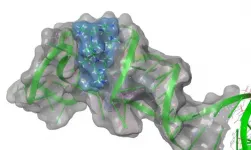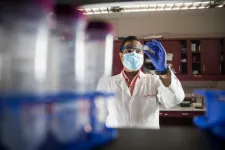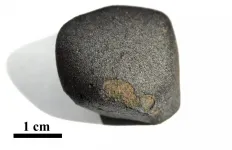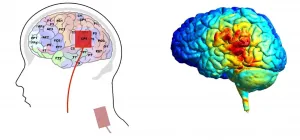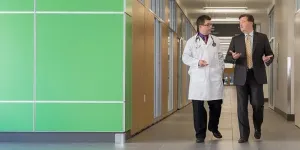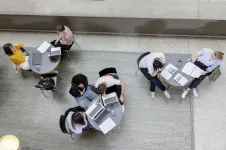INFORMATION:
The lead authors on the paper are graduate students Ali Aldhumani and Ismail Hossain, both pursuing a PhD in Chemistry at OHIO, along with graduate student Emily Fairchild, pursuing a masters in Chemistry at OHIO. In addition to Hannah Boesger and Emily Marino, the third undergraduate author is Mason Myers, recently named a Goldwater Scholar.
The Hines lab paper is titled "RNA Sequence and Ligand Binding Alter Conformational Profile of SARS-CoV-2 Stem Loop II Motif." It is published in the journal Biochemical and Biophysical Research Communications.
OHIO researchers ID potential target for anti-viral drugs to battle COVID
OHIO researchers published the first structural biology analysis of a section of the COVID-19 viral RNA called the stem-loop II motif.
2021-01-21
(Press-News.org) ATHENS, Ohio (Jan. 20, 2021) - While the world awaits broad distribution of COVID-19 vaccines, researchers at Ohio University just published highly significant and timely results in the search for another way to stop the virus -- by disrupting its RNA and its ability to reproduce.
Dr. Jennifer Hines, a professor in the Department of Chemistry and Biochemistry, along with graduate and undergraduate students in her lab, published the first structural biology analysis of a section of the COVID-19 viral RNA called the stem-loop II motif. This is a non-coding section of the RNA, which means that it is not translated into a protein, but it is likely key to the virus's replication.
"If you've been following the development of the vaccines, the current vaccines give our cells instructions to make a small piece of protein," Hines said. "This protein fragment then triggers an immune response that will protect us if exposed to the real virus. In contrast, we are studying a section of RNA that does not code for proteins and is found in the coronavirus causing COVID-19 and other similar viruses. We are comparing it with the viral RNA from the SARS outbreak nearly 20 years ago -- and looking for a possible target for an anti-viral drug that can attack the virus and stop it from reproducing. We are looking for the Achilles heel of the COVID-19 virus.
"The RNA genome of the coronavirus causing the COVID-19 pandemic is extremely efficient at commandeering human cells to produce more virus particles," Hines added. "Our studies focused on a very small piece at the very end of this genome that is also present in other similar viruses. We found that the structural flexibility of this RNA motif may be related to its viral function and that it could potentially be disrupted with small molecules similar to the medicines we take to treat bacterial infections."
Hines' research found that the stem-loop II motif section of the viral RNA is "highly conserved in the COVID-19 virus, meaning that while other parts of the virus continue to evolve, this part of the virus is normally like a rock. And for the virus to cause disease, it needs to keep replicating inside the human body. So we are looking at this section of the RNA as a possible target for an antiviral."
To learn more about this tiny section of COVID RNA, Hines' lab took a big-data approach before starting the lab-based research. Using the Ohio Supercomputer Center, which provided priority, unbilled access to computational and storage resources for COVID-19 research, Hines found differences in the predicted three-dimensional RNA structure between the virus that caused the earlier SARS outbreak and the one causing the COVID-19 outbreak.
Shifting to Remote Courses and Research Led to COVID Discovery
When COVID-19 hit last spring, Hines was poised to have her medicinal chemistry class study anti-viral agents and her undergraduate tutorial students pursue computational RNA drug discovery.
"Despite and because of the COVID-19 pandemic, these classroom and tutorial topics have now turned into powerful online teachable moments," Hines said at the time.
In class, her students used Blackboard's Group Wiki tools to discuss molecular drug targets for inhibiting SARS-CoV-2, the virus that causes COVID-19. In her lab, students began to use the Ohio Supercomputer Center to investigate the three-dimensional structure of the RNA important for SARS-CoV-2 replication. Their work included docking drug molecules to the RNA to see if any existing drugs might potentially disrupt the RNA's function.
"Three of the authors on the paper are Honors Tutorial College students, and two of these students -- Hannah Boesger and Emily Marino -- are the ones with whom the whole project started as part of their spring tutorial with me when we had to shift everything online for the second half of the semester," Hines said.
"I personally view this as the most meaningful paper of my entire academic career partly due to the significance of the topic, but also due to the seamless combination of undergraduate and graduate teaching and research, which is what originally drew me to Ohio University and is what I believe is one of the University's greatest strengths," Hines said.
Finding a Potential Vulnerability
As their work progressed, the OHIO researchers, with graduate students Ali Aldhumani and Ismail Hossain in the lead, focused in on a single nucleotide, how it differs between the two outbreaks, and where it might make the RNA motif vulnerable to attack. Nucleotides are organic molecules that are the building blocks of nucleic acids, and thus of RNA and DNA.
"Using complementary biochemical and computational methods, we determined that the structural flexibility of this important noncoding RNA motif differs compared to that in the early 2000s SARS-CoV outbreak by only a single nucleotide change. We also identified FDA-approved drugs that bind the RNA motif and alter its flexibility. This was an exciting observation since the structure and flexibility of noncoding RNA affects its function, indicating that it may be possible to develop anti-viral therapeutics that specifically target this RNA motif and disrupt its function."
ELSE PRESS RELEASES FROM THIS DATE:
University of Kentucky researchers link low blood amylin level to reduced progression of Alzheimer's
2021-01-21
LEXINGTON, Ky. (January 20, 2021) - More than 5.7 million Americans live with Alzheimer's disease and that number is projected to triple by 2050. Despite the growing number there is not a cure. Florin Despa a professor with the University of Kentucky's department of pharmacology and nutritional sciences says, "The mechanisms underlying neurodegenerative diseases are largely unknown and effective therapies are lacking." That is why numerous studies and trials are ongoing around the world including at the University of Kentucky. One of those studies by University of Kentucky researchers was recently published in Alzheimer's & Dementia: Translational Research & Clinical Interventions. It is the ...
Age provides a buffer to pandemic's mental health impact, University of Connecticut researchers say
2021-01-21
Older adults are managing the stress of the coronavirus pandemic better than younger adults, reporting less depression and anxiety despite also experiencing greater general concern about COVID-19, according to a study recently published by researchers at the UConn School of Nursing.
Their somewhat paradoxical findings, published last month in the journal Aging and Mental Health, suggest that although greater psychological distress has been reported during the pandemic, older age may offer a buffer against negative feelings brought on by the virus's impact.
"When you think about older adulthood, oftentimes, there are downsides. For example, with regard to physical well-being, we don't recover as well from injury or ...
Beetles reveal how to hide the body
2021-01-21
Not long after the sun goes down, pairs of burying beetles, or Nicrophorus orbicollis, begin looking for corpses.
For these beetles, this is not some macabre activity; it's house-hunting, and they are in search of the perfect corpse to start a family in. They can sense a good find from miles away, because carrion serves as a food source for countless members of nature's clean-up crew. But because these beetles want to live in these corpses, they don't want to share their discovery. As a result, burying beetles have clever ways of claiming their decaying prize all for themselves. In new research published in The American Naturalist, researchers from UConn and The University of Bayreuth have found these beetles recruit microbes to help throw rivals off the scent.
Immediately following ...
Researchers study what happens to your body during tailgating
2021-01-21
The NFL playoffs are underway, and fans are finding ways to simulate tailgating during the COVID-19 pandemic. Football watch parties are synonymous with eating fatty foods and drinking alcohol. Have you ever wondered what all of that eating and drinking does to your body?
Researchers from the University of Missouri School of Medicine simulated a tailgating situation with a small group of overweight but healthy men and examined the impact of the eating and drinking on their livers using blood tests and a liver scan. They discovered remarkably differing responses in the subjects.
"Surprisingly, we found that in overweight men, after an afternoon of eating and drinking, how their bodies reacted to food and drink was not uniform," said Elizabeth Parks, PhD, professor of nutrition and ...
Tree rings and the Laki volcano eruption: A closer look at climate
2021-01-21
University of Arizona researchers read between the lines of tree rings to reconstruct exactly what happened in Alaska the year that the Laki Volcano erupted half a world away in Iceland. What they learned can help fine-tune future climate predictions.
In June 1783, Laki spewed more sulfur into the atmosphere than any other Northern Hemisphere eruption in the last 1,000 years. The Inuit in North America tell stories about the year that summer never arrived. Benjamin Franklin, who was in France at the time, noted the "fog" that descended over much of Europe in the aftermath, and correctly reasoned that it led to an unusually cold winter on the continent.
Previous analyses of annual tree rings have shown that the entire 1783 growing season for the spruce ...
Oldest carbonates in the solar system
2021-01-21
A meteorite that fell in northern Germany in 2019 contains carbonates which are among the oldest in the solar system; it also evidences the earliest presence of liquid water on a minor planet. The high-resolution Ion Probe - a research instrument at the Institute of Earth Sciences at Heidelberg University - provided the measurements. The investigation by the Cosmochemistry Research Group led by Prof. Dr Mario Trieloff was part of a consortium study coordinated by the University of Münster with participating scientists from Europe, Australia and the USA.
Carbonates are ubiquitous rocks on Earth. They can be found in the mountain ranges of the Dolomites, the chalk cliffs on the island of Rügen, and in the coral reefs of the ...
Direct current stimulation of the brain over Wernicke's area can help people learn new words
2021-01-21
Transcranial direct current stimulation (tDCS) is a non-invasive method of brain stimulation, in which electrodes are applied over certain places on the scalp, creating a weak electric field. It is currently used for a variety of purposes: from treating depression and pain syndromes to better acquisition of new words and even sports techniques.
During stimulation, the active electrode can transmit a positive or negative electrical charge. In the former case, this stimulation is called 'anodal'; in the latter one, it is called 'cathodal'. Researchers believe that anodal tDCS generally leads to depolarisation of neurons, which increases the likelihood of their excitation when new information arrives. Cathodal ...
Incentivizing vaccine adherence: could it be the key to achieving herd immunity?
2021-01-21
As the United States struggles to control record-breaking increases in COVID-19 infections and hospitalizations, the roll-out of two approved vaccines offers tremendous hope for saving lives and curbing the pandemic. To achieve success, however, experts estimate that at least 70 to 90 percent of the population must be inoculated to achieve herd immunity, but how can we ensure folks will voluntarily receive a vaccine?
Both vaccines require two injections. Pfizer-BioNTech's second dose must be given 21 days after the first and Moderna's second dose must be administered 28 days after the first. While public health and infectious disease experts have discussed strategies to enhance adherence, including the potential use of financial incentives, ...
Target of new cancer treatment valid for breast as well as blood cancers: study
2021-01-21
One more piece of the puzzle has fallen into place behind a new drug whose anti-cancer potential was developed at the University of Alberta and is set to begin human trials this year, thanks to newly published research.
"The results provide more justification and rationale for starting the clinical trial in May," said first author John Mackey, professor and director of oncology clinical trials in the Faculty of Medicine & Dentistry. "It's another exciting stepping stone to finding out if this is going to be a new cancer treatment."
The drug PCLX-001 is designed to selectively kill cancer cells by targeting enzymes ...
How fellow students improve your own grades
2021-01-21
Better grades thanks to your fellow students? A study conducted by the University of Zurich's Faculty of Business, Economics and Informatics has revealed that not only the grade point average, gender and nationality peers can influence your own academic achievement, but so can their personalities. Intensive contact and interaction with persistent fellow students improve your own performance, and this effect even endures in subsequent semesters.
Personality traits influence many significant outcomes in life, such as one's educational attainment, income, career achievements or health. Assistant Professor Ulf Zölitz of the University of Zurich's Department of Economics and Jacobs Center for Productive Youth Development has investigated how one's own personality affects fellow students.
The ...
LAST 30 PRESS RELEASES:
New science reporting guide published for journalists in Bulgaria
New international study reveals major survival gaps among children with cancer
New science reporting guide published for journalists in Turkey
Scientists develop a smarter mRNA therapy that knows which cells to target
Neuroanatomy-informed brain–machine hybrid intelligence for robust acoustic target detection
Eight SwRI hydrogen projects funded by ENERGYWERX
The Lundquist Institute and its start-up company Vitalex Biosciences Announces Strategic Advancement of Second-Generation fungal Vaccine VXV-01 through Phase 1 Trials under $40 Million Competitive Con
Fine particles in pollution are associated with early signs of autoimmune disease
Review article | Towards a Global Ground-Based Earth Observatory (GGBEO): Leveraging existing systems and networks
Penn and UMich create world’s smallest programmable, autonomous robots
Cleveland researchers launch first major study to address ‘hidden performance killer’ in athletes
To connect across politics, try saying what you oppose
Modulating key interaction prevents virus from entering cells
Project explores barriers to NHS career progression facing international medical graduates
Jeonbuk National University researchers explore the impact of different seasonings on the flavor perception of Doenjang soup
Two Keck Medicine of USC Hospitals named Leapfrog Top Teaching Hospitals
World-first discovery uncovers how glioblastoma tumours dodge chemotherapy, potentially opening the door to new treatments
A fatal mix-up: How certain gut bacteria drive multiple sclerosis
New AI tool identifies not just genetic mutations, but the diseases they may cause
Deep-learning model predicts how fruit flies form, cell by cell
Combination pills for high blood pressure may simplify treatment, improve long-term health
Immune system keeps mucosal fungi in check
Neurons within the brain use simple rules to localize genetic messages
Electrodes created using light
Second-hand gift-giving is a well-deliberated decision
How human interaction drove evolution to make bears less aggressive
National Poll: Few parents offer teens guidance on healthy eating during holiday season
Cannabis derivatives could provide new ovarian cancer treatments
Raising strong yeast as a petroleum substitute
Clues to the origin of hot Jupiters hidden in their orbits
[Press-News.org] OHIO researchers ID potential target for anti-viral drugs to battle COVIDOHIO researchers published the first structural biology analysis of a section of the COVID-19 viral RNA called the stem-loop II motif.
